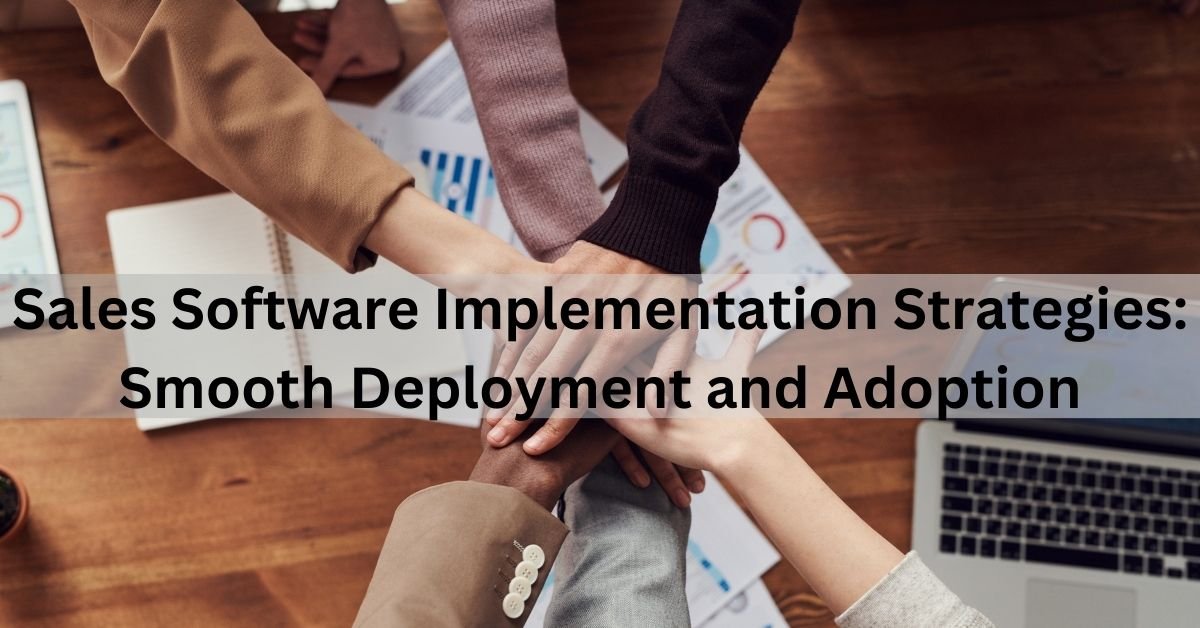Investing in a new sales software can be a game-changer for your business. It promises streamlined workflows, improved data analysis, and ultimately, a boost in sales. But the journey from purchase to peak performance isn’t always smooth sailing. A poorly implemented sales software can lead to user frustration, data silos, and lost revenue.
Fear not, intrepid sales leader! With the right strategies, you can navigate the implementation process and ensure your team embraces the new system with open arms. Here’s your roadmap to a smooth deployment and widespread adoption:
1. Assembling Your Sales Software Champion Team: A Deep Dive
Building a strong champion team is the bedrock of a successful sales software implementation. These individuals will be your evangelists, troubleshooters, and the driving force behind user adoption. But how do you find the right people and empower them to champion this change? Let’s delve deeper:
Executive Sponsor:
- Who to look for: A high-level leader with influence across the organization. Ideally, someone who has experienced the pain points the software aims to solve and understands its potential impact.
- What they do: Advocate for the software, remove roadblocks by allocating resources and resolving cross-departmental conflicts. They are the vocal supporter who keeps the project moving forward.
Project Manager:
- Who to look for: A tech-savvy individual with excellent organizational skills and project management experience. Bonus points for familiarity with similar software implementations.
- What they do: Develop a detailed implementation plan, manage timelines and budgets, track progress, and ensure all tasks are completed efficiently. They are the conductor of the implementation orchestra.
Business Users:
- Who to look for: A diverse group of representatives from different sales roles (e.g., account executives, sales development reps, managers) who are familiar with the current processes and challenges.
- What they do: Provide valuable insights on workflows, data needs, and customization requirements. They test functionalities, identify potential roadblocks, and train their peers, becoming the on-the-ground experts and champions within their teams.
Pro Tip: When selecting your champions, prioritize individuals who are:
- Tech-savvy and adaptable: They should be comfortable learning new technologies and embracing change.
- Natural communicators: They can clearly articulate the benefits of the software and inspire others to use it.
- Influential and respected: Their peers trust their judgment and value their opinions.
- Passionate about sales: They genuinely believe in the power of the software to improve their individual and team performance.
Empowering Your Champions:
- Provide comprehensive training: Equip them with in-depth knowledge of the software, beyond basic features. Focus on functionalities relevant to their specific roles and responsibilities.
- Foster collaboration: Create a platform for champions to share best practices, address challenges collectively, and learn from each other’s experiences.
- Recognize and reward their efforts: Publicly acknowledge their contributions, celebrate successes, and offer incentives for exceeding adoption goals. This keeps them motivated and reinforces their leadership role.
Remember, your champion team is your secret weapon. Invest in their development, empower them to lead by example, and witness the domino effect of widespread user adoption.
2. Defining Your Sales Software Goals and Objectives: From Vision to Measurable Success
A sales software implementation without clear goals is like a ship without a rudder. You might end up somewhere, but it won’t be the promised land of increased sales and streamlined processes. So, let’s set sail with a roadmap, shall we?
Start with the Big Picture:
- What are your overall sales objectives? Do you want to increase revenue by 20%? Shorten the sales cycle by 15%? Improve customer satisfaction by 10%? Define these ambitious, yet achievable, goals as your North Star.
- Align goals with company strategy: Ensure your sales software goals contribute to the broader organizational objectives. This creates a unified vision and motivates stakeholders across departments.
Break it Down into Bite-Sized Objectives:
- Specificity is key: Don’t just say “improve lead generation.” Be specific – “Increase qualified leads by 30% within the next quarter.” This provides a clear target for measurement and evaluation.
- Actionable for each team: Translate your overarching goals into actionable objectives for each sales department or team. For example, the marketing team might aim to “generate 50% more website leads that convert into qualified leads.”
- SMARTer is better: Remember the SMART framework – Specific, Measurable, Achievable, Relevant, and Time-bound. This ensures your objectives are well-defined, realistic, and contribute to the overall timeline.
Beyond the Numbers:
- Qualitative objectives: Don’t forget about the softer aspects! Aim to “improve team collaboration” or “increase user satisfaction with the new software.” These goals, while less quantifiable, are crucial for long-term adoption and positive user experience.
- Data-driven decisions: Use historical data and industry benchmarks to set realistic and achievable objectives. This prevents you from aiming too high or too low.
Communicate and Track:
- Transparency is key: Share your goals and objectives openly with the entire sales team. This fosters ownership, engagement, and a sense of shared purpose.
- Regular monitoring: Establish a system for tracking progress towards your objectives. Use data dashboards, reports, or even team meetings to review performance and identify areas for improvement.
- Celebrate wins (big and small): Acknowledge and celebrate even small milestones. This keeps the team motivated and reinforces the positive impact of their efforts.
Remember, defining goals and objectives is an iterative process. As you gather data and feedback, you might need to adjust your targets or strategies. Be flexible, adapt as needed, and keep your eyes firmly on the prize – a sales team empowered by technology to achieve remarkable success.
3. Configuration and Customization: Tailoring Your Sales Software for Peak Performance
Imagine buying a fancy sports car but leaving it in factory mode. You wouldn’t unlock its full potential, right? The same goes for your sales software. Configuration and customization are the keys to transforming it from a generic tool into a perfectly tuned machine for your unique sales process.
Configuration vs. Customization:
- Configuration: Think of it as adjusting the dials and levers within the existing car. You can personalize dashboards, set up workflows, and define data fields without changing the underlying engine. It’s like using pre-built Legos to create something specific.
- Customization: This is where you tinker under the hood, potentially modifying the software’s code to add entirely new features or functionalities that the base model doesn’t offer. It’s like building your own car from scratch, with all the bells and whistles you desire.
Finding the Right Balance:
- Start with configuration: Exhaust the built-in options before diving into customization. Most sales software offers a surprising degree of flexibility through configuration alone. This is often faster, cheaper, and less prone to errors.
- Customize strategically: Only venture into customization when absolutely necessary. It requires technical expertise, can be time-consuming and expensive, and might create compatibility issues with future software updates.
Here’s how to leverage both effectively:
- Data migration: Plan a seamless transition of your existing customer information and sales history. Ensure accuracy, avoid duplicates, and configure fields to match your data structure.
- Integrations: Connect your sales software with other key systems like CRM, marketing automation, or accounting platforms. This eliminates manual data entry and creates a unified data ecosystem.
- Workflow automation: Configure automated triggers and actions based on specific criteria. For example, automatically send follow-up emails after a meeting or assign leads based on location.
- Custom fields and reports: Create fields and reports tailored to your specific data needs and sales metrics. This allows for granular analysis and insights into your unique sales funnel.
- Advanced customization: If needed, consider building custom dashboards, adding unique functionalities, or even integrating with niche industry tools.
Remember:
- Involve your users: Get feedback from your sales team throughout the configuration and customization process. This ensures the software caters to their needs and fosters a sense of ownership.
- Test and iterate: Don’t set it and forget it. Regularly test your configurations, analyze data, and gather user feedback. Be prepared to adapt and refine your approach based on real-world usage.
By mastering the art of configuration and customization, you can transform your sales software from a generic tool into a powerful, personalized engine that drives sales success. So, roll up your sleeves, get creative, and unlock the true potential of your software investment!
4. Training and Adoption Champions: Your Secret Weapon for Sales Software Implementation
A robust sales software sits idle without user adoption. It’s like having a Ferrari in the garage, collecting dust. To truly reap the benefits, you need passionate advocates who ignite user engagement and drive widespread adoption. Enter the training and adoption champions – your secret weapon for unlocking the software’s full potential.
Who are these champions?
They are your sales team’s internal rockstars – enthusiastic early adopters who possess a unique blend of:
- Tech-savvy knowledge: They grasp the software’s intricacies and can navigate its features with ease.
- Communication prowess: They articulate the software’s value proposition clearly and compellingly, inspiring others to follow their lead.
- Leadership qualities: They are trusted peers who readily answer questions, offer support, and champion positive change.
- Genuine passion for sales: They believe in the software’s power to improve individual and team performance.
How do you empower them?
- Invest in their expertise: Provide them with in-depth training beyond basic features. Focus on functionalities relevant to their roles and equip them with the knowledge to answer user queries confidently.
- Foster a champion community: Create a platform for champions to share best practices, troubleshoot challenges collectively, and learn from each other’s experiences. This fosters collaboration and keeps them engaged.
- Recognize and reward their efforts: Publicly acknowledge their contributions, celebrate successes, and offer incentives for exceeding adoption goals. This fuels their motivation and reinforces their leadership role.
Beyond training, unleash their adoption superpowers:
- Develop bite-sized training modules: Cater to busy schedules with short, focused sessions on specific features or workflows. Make it easy for users to learn on their own time.
- Create a “go-to” champion network: Designate champions as points of contact for different teams or departments. This ensures readily available support and builds trust within the user community.
- Gamify the process: Encourage friendly competition with leaderboards for software usage or “aha moment” sharing. This adds a fun element and motivates users to explore and learn.
- Gather and address feedback: Actively solicit user input through surveys, focus groups, or suggestion boxes. Champions can then relay concerns and advocate for improvements, ensuring the software evolves with user needs.
Remember, training and adoption champions are not a one-time investment. Nurture their skills, provide ongoing support, and celebrate their wins. By empowering these passionate individuals, you’ll witness a domino effect of user engagement, driving your sales software from a dusty tool to a powerful engine of success.
So, go forth, identify your champions, and unleash the collective power of your sales team to unlock the full potential of your sales software!
5. Communication is Key: Unlocking Sales Software Adoption through Open Dialogue
A powerful sales software sits idle without clear, consistent communication. It’s like having a whisper in a crowded room – important messages get lost, and enthusiasm dwindles. To bridge the gap between technology and user adoption, communication is your secret weapon. Here’s how to wield it effectively:
Transparency is your guiding principle:
- Keep everyone informed: Regularly communicate progress updates, address challenges transparently, and celebrate successes. This fosters trust, prevents information silos, and keeps users invested.
- Set expectations: Be upfront about the implementation timeline, potential roadblocks, and the learning curve involved. This manages anxieties and prevents frustration.
- Benefits, not features: Focus on how the software benefits users directly. Highlight improved efficiency, increased sales opportunities, and access to valuable data. This makes the change personal and impactful.
Tailor your communication channels:
- Team meetings: Utilize regular sales meetings to address broad updates, gather feedback, and answer common questions. This fosters a sense of community and shared purpose.
- Targeted emails: Segment your audience and send relevant information based on roles or departments. This personalizes the communication and reduces information overload.
- Short video tutorials: Create bite-sized video guides showcasing specific features or workflows. This caters to visual learners and provides on-demand support.
- Internal champion network: Leverage your adoption champions as communication hubs. They can answer questions, share tips, and offer peer-to-peer support, building trust and camaraderie.
Embrace two-way dialogue:
- Actively solicit feedback: Use surveys, focus groups, or suggestion boxes to gather user input. This identifies concerns early, allows for course correction, and demonstrates that their voices matter.
- Open forum for discussions: Create a platform for users to ask questions, share experiences, and learn from each other. This fosters collaboration and problem-solving within the team.
- Address concerns promptly: Don’t shy away from negative feedback. Acknowledge challenges, provide solutions, and demonstrate your commitment to user satisfaction. This builds trust and shows you’re listening.
Remember, communication is an ongoing process:
- Regularly revisit and adapt: As you gather data and feedback, refine your communication strategies. Address evolving needs, celebrate milestones, and keep the conversation going.
- Recognize and reward communication champions: Acknowledge individuals who actively engage, share knowledge, and contribute to a positive communication culture. This reinforces their role and inspires others to follow suit.
By embracing open, transparent communication, you transform your sales software implementation from a top-down directive into a collaborative journey. Users become invested partners, not passive recipients. And as the dialogue flows freely, watch adoption rates soar, and your sales team unlock the true potential of their powerful new tool.
So, pick up your communication megaphone, amplify the benefits, and let the conversation begin! Your sales software and your team will thank you for it.
Remember, defining goals and objectives is an iterative process. As you gather data and feedback, you might need to adjust your targets or strategies. Be flexible, adapt as needed, and keep your eyes firmly on the prize – a sales team empowered by technology to achieve remarkable success.




